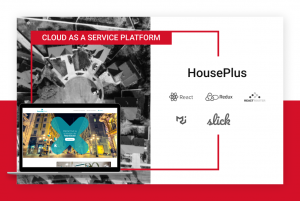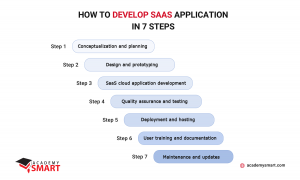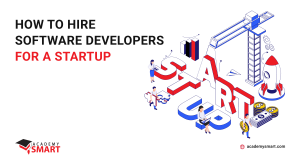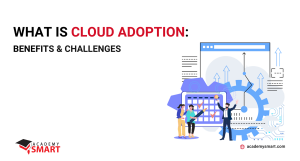SaaS Software Development in 2023: A Guide for Businesses
In 2023, SaaS software development is a pivotal opportunity for businesses seeking growth and innovation. As the cloud computing market continues its rapid expansion, embracing SaaS technology has become essential for staying competitive. This guide will provide insights into SaaS development best practices, empowering enterprises to harness the advantages of cloud-based solutions while reducing maintenance costs.
What is Custom SaaS Application Development
Software as a Service (SaaS) represents a modern approach to software product delivery, revolutionizing how businesses access and utilize applications. In this model, SaaS apps are hosted on outlying cloud servers and made available through web browsers or APIs. Unlike traditional software, SaaS applications are not installed locally on users’ devices. Instead, they are accessed remotely, sparing users from the complexities of installation, maintenance, and hardware upgrades.
The hallmark of SaaS lies in its subscription-based, on-demand nature. The cloud SaaS solution providers are responsible for software maintenance, including updates, security, and infrastructure. This efficient, cost-effective approach has fueled the rapid growth of SaaS, with the SaaS app market projected to reach a staggering $208 billion by the end of 2023, making it a dominant force in the software industry.
SaaS applications cover various functionalities and cater to diverse user needs. Famous examples include project management tools like Jira, communication platforms like Slack, file-sharing services like Dropbox, and entertainment platforms like Netflix and Spotify.
In the realm of SaaS application development, the process is continuous. Developers work tirelessly to update and enhance their offerings to attract more users and stay competitive. This perpetual cycle of improvement ensures that SaaS platforms remain relevant and effective in meeting the ever-evolving demands of businesses and consumers.
As businesses increasingly recognize the benefits of SaaS product development, the market continues to expand, with startups and established tech giants capitalizing on this transformative model. Azure, Amazon Web Services (AWS), Google Cloud, and other industry leaders have witnessed impressive growth, underscoring the immense potential of building SaaS platforms.
Custom SaaS development is the art of creating cloud-based software applications that eliminate the burdens of traditional software deployment. It offers flexibility, scalability, and cost-efficiency, making it attractive for businesses seeking new competitive advantages.
SaaS platform definition and specificity
Cloud-based Software as a service embodies a unique approach to application development built upon the leverage of microservices. Microservices are those core elements of SaaS solutions responsible for handling specific functions or capabilities within the software app. They are designed to work together to deliver the full range of the SaaS application’s features and services.
A modular architecture lies at the foundation of a SaaS platform, where the entire application is deconstructed into small, self-contained microservices. Each assumes responsibility for a specific business feature, such as user management, data processing, authentication, or billing.
Each microservice can be deployed, managed, and scaled independently, optimizing resource utilization and simplifying maintenance. The modularity permits individual microservices to be horizontally scaled to meet varying demands. Consequently, during fluctuations in user activity, a SaaS application can effortlessly allocate resources where needed, ensuring consistent performance and responsiveness. On the other side, microservices provide a robust fault isolation mechanism. If one microservice experiences a failure, it does not necessarily disrupt the entire application. This isolation enhances overall system reliability, a critical aspect for SaaS platforms where system downtime can have significant consequences.
Microservices utilization simplifies maintenance and upgrades of SaaS applications. Updating of individual microservices can be performed without causing disruptions across the entire app. Moreover, the flexibility to use diverse technologies and programming languages for each microservice ensures compatibility with various third-party services, databases, and technologies.
In SaaS applications, where databases are instrumental for storing user and application information, microservices can be coupled with individual data stores. This approach simplifies database scaling, maintenance, and schema changes. It prevents changes to one microservice’s database from affecting others, contributing to streamlined operations.
Business SaaS applications often employ a multi-tenant architecture, where a single infrastructure serves multiple customers. At the same time, each customer’s data remains isolated and secured from others. Two typical implementations of cloud multi-tenancy are:
- One app instance with one database
All users access a single application instance connected to a shared database. While simple, this can limit scalability. - One app instance with several databases
Users are distributed across multiple databases, enhancing performance and responsiveness at the expense of increased complexity.
In contrast, single-tenant architecture means each customer uses a dedicated instance of the software, offering enhanced security but requiring more resources for maintenance.
Expertise needed for enterprise SaaS application development
Building a SaaS application requires a specific set of technical expertise and considerations. The success of such a project relies on a well-rounded development team and the right technology stack. Here are the essential technical requirements for a SaaS development team:
- Technology stack mastery
Choosing the right tech stack is crucial for the success of an enterprise SaaS application development. It includes selecting appropriate programming languages, coding frameworks, and tools. Today’s common choices include Angular, React, Vue.js for front-end development and Node.js, PHP, Python, or Java for back-end coding. The technology stack should align with the application’s requirements and scalability needs. - Database expertise
A robust and flexible database is essential for storing and managing data effectively. The development team should have expertise in selecting the correct type of database based on factors like data nature, scalability requirements, anticipated load, and budget constraints. It is crucial to understand the differences between database options and their service level agreements (SLAs). - Cloud Computing Services (e.g., AWS, Azure, GCP)
Cloud expertise is crucial for managing the infrastructure, ensuring scalability, optimizing resource usage, enhancing security, achieving high availability, and leveraging advanced services like data analytics and machine learning. It also enables effective monitoring and management of the SaaS application. - Third-party integrations
Many business SaaS applications must integrate with other third-party solutions that clients may use. The development team should have experience integrating various APIs, services, and tools such as Jira, Slack, or Zoom. Seamless integration enhances the application’s functionality and usability. - Security measures
Security is prominent in enterprise SaaS development. The team should implement robust security measures, including data encryption, secure authentication, and regular security audits. Compliance with relevant data protection regulations should be a priority to protect user data and build trust. - User Interface and Experience
A well-designed user interface and a positive user experience are crucial for user adoption and retention. The application should be user-friendly, featuring straightforward navigation and an appealing design that allows users to interact efficiently with its features. - Frequent updates
Continuous improvement and updates are essential for keeping the SaaS application relevant and competitive. DevOps practices and tools like Kubernetes can automate deployment, scaling, and management of the cloud infrastructure, making it easier to roll out regular updates and enhancements.
SaaS vs custom web application development: main differences
Let’s compare cloud-based Software-as-a-Service, web-based applications, and custom on-premise software.
Deployment and accessibility
SaaS applications are hosted in the cloud storages and accessed over the internet. They offer the advantage of immediate accessibility from any device with an internet connection, making them highly convenient for users. Custom online applications are also web-hosted. They offer accessibility similar to SaaS but are designed to meet unique requirements. On-premise applications are installed and run locally on a company’s servers or infrastructure. They require physical hardware and maintenance, limiting accessibility to on-site locations.
Maintenance and updates
SaaS solution providers handle all maintenance, updates, and security patches. Users benefit from the latest features and improvements without manual intervention. Maintenance and updates for custom web applications are typically the responsibility of the business or development team. That gives businesses more control but requires dedicated resources. On-premise applications require companies to manage all aspects of maintenance, including server updates, security, and hardware replacement.
Scalability
SaaS applications are designed for scalability. Users can quickly scale up or down based on their needs, often with flexible subscription models. The scalability of custom web software depends on the architecture and planning. They can be scaled but may require additional development effort. Scaling on-premise applications can be complex and costly, involving hardware upgrades and infrastructure changes.
Customization
SaaS software applications offer some customization but are usually developed with a standardized feature set to serve a broad user base. Custom web apps are highly customizable and tailored to meet unique enterprise requirements and workflows. On-premise apps can be fully customized to align with individual business processes but may require significant development and maintenance efforts.
Cost structure
SaaS apps often have a subscription-based pricing model, offering predictable monthly or annual costs. It can be cost-effective for small to medium-sized businesses. Web-based apps may have higher initial development costs but can provide long-term cost savings, especially for large enterprises with specific needs. On-premise solutions typically involve higher upfront costs for hardware and infrastructure and ongoing maintenance expenses.
Security and compliance
SaaS providers make investments in reliable security measures and compliance certifications. Data security and compliance are shared responsibilities between the provider and the user. Security measures in web applications are implemented according to the industry-specific requirements and can address compliance needs. Security and compliance of on-premise solutions are the organization’s responsibility, requiring dedicated resources and expertise.
As you may see, SaaS software development offers convenience and cost-effectiveness with minimal maintenance, making it suitable to embody many business ideas.
SaaS product development challenges
Note that the specifics of SaaS application development can present you with several severe challenges in addition to the nuances listed above.
First, you need a competent development team with a customer-centric mindset, a focus on scalability and adaptability, a collaborative approach, and a problem-solving orientation. It has to create solutions that function well, effectively address customer needs, and contribute to business growth.
Migrating features and data of existing on-premise or simple web application to the cloud or cloud-to-cloud transfer requires careful execution. Your SaaS development team should plan the migration meticulously, consider data security, and ensure compatibility with the chosen cloud platform. You may read about this process in the post “What is Cloud Migration: benefits, types and strategies.”
Managing various aspects of the subscription lifecycle, including subscribing, upgrading, canceling, and unsubscribing, can be challenging. You must choose between building a subscription system from scratch or utilizing external APIs based on the project’s needs and complexity.
Your SaaS development company must update the application regularly without causing downtime for users. It should be able to adopt no-downtime deployment strategies like blue-green deployments, for example, to ensure continuous accessibility.
Key Benefits of Developing SaaS Applications for Business
What are the main advantages of custom SaaS development?
Cost efficiency
Utilizing serverless infrastructure, SaaS applications eliminate businesses’ need to invest heavily in hardware and specific software licenses. This approach allows organizations to allocate resources more efficiently and reduce upfront expenses. Businesses spend for SaaS deployment on a subscription basis, which often proves more budget-friendly in the long run, especially when regularly leveraging complex cloud computing. Moreover, this payment model provides enterprises with predictable costs.
Flexible scalability
SaaS applications offer unparalleled scalability, making them adaptable to growing user bases and evolving business needs. They can handle increased workloads and support larger user numbers without performance degradation. In addition, SaaS apps can be quickly deployed, and updates are seamless. Users can access the latest features and improvements without time-consuming installations or software updates. This scalability may be beneficial for businesses experiencing fast expansion or erratic demand.
Reliability and safeness
Cloud-based SaaS applications rely on a network of services worldwide. This redundancy ensures high reliability, as even if one server experiences issues, the SaaS products continue to function. Downtime is minimized, and users can access their applications reliably. In addition, SaaS solutions often include encryption and secure authentication to ensure data safety.
Leveraging cutting-edge technology trends
SaaS applications harness the power of big data and advanced analytics to provide users with valuable insights. By processing and analyzing large datasets in the cloud, SaaS apps can offer data-driven recommendations, predictive analytics, and reporting tools that enable smarter decision-making.
Many modern SaaS platforms integrate artificial intelligence (AI) and machine learning (ML) capabilities. This allows them to automate tasks, enhance user experiences, and provide personalized recommendations.
SaaS development is increasingly adopting low-code/no-code platforms. These tools enable faster application development by allowing users to build software with minimal coding. SaaS providers use these platforms to accelerate the release of new features and applications, making them more agile and responsive to customer needs.
MicroSaaS is another growing trend where smaller, specialized SaaS solutions cater to niche markets. These applications are highly focused, delivering targeted functionality. They leverage cloud infrastructure to provide cost-effective and scalable services, making them accessible to a wider range of businesses.
These and other benefits that we discussed earlier make it profitable to develop various SaaS applications, among which the most popular types are the following:
- Customer Relationship Management (CRM) apps;
- Enterprise Resource Planning (ERP) applications;
- Human Resources Management System (HRMS);
- Project Management tools;
- Accounting and Financial Software;
- Content Management Systems (CMS);
- Marketing Automation software;
- E-commerce platforms;
- Business Intelligence and Analytics software;
- Help Desk and Customer Support Systems;
- Learning Management Systems (LMS);
- Social Media Management Tools;
- Video Conferencing and Webinar platforms;
- Inventory Management Software;
- Legal Practice Management Software;
- Healthcare Management Systems;
- Real Estate Management Software;
- Booking Service Management Tools;
- Fleet Management Software and others.
The portfolio of SaaS application development company Academy Smart is rich in examples of high-performance cloud-based systems in various business sectors. Here is, for instance, the AI-driven real estate app that our team developed for large companies in the industry.

Cloud-based real estate SaaS application our team delivered
SaaS App Development Process
Creating a SaaS product sets it apart from the usual web or mobile app development journey. The fundamental difference lies in the need for a trustworthy cloud service provider, the infrastructure of which will be used for deployment. Among the prominent choices stands Amazon Web Services (AWS), offering a treasure trove of tools tailored for SaaS developers. The following 7-step guide will delve into the specific stages and considerations that make SaaS application development unique and successful.
Step 1. Conceptualization and planning
Clearly outline the objectives of your SaaS solution and identify the specific requirements. Consider how the software aligns with your business aims, the need for expert resources, and its relation to your other initiatives. Exhaustively study the market, target audience, and contestants. Understand your SaaS product’s unique value and how it can stand out in the market.
Assemble a skilled development team, including a project manager, software architect, and business analysts. Collaborate closely to plan your SaaS project effectively. Develop a clear strategy for your SaaS development, including the business, pricing, and monetizing models. Explore freemium options, flat-rate pricing, usage-based pricing, and tiered pricing. Create a SaaS product development roadmap that outlines the project’s milestones, objectives, and critical timelines. It will benefit as a guide throughout the development journey.
Choose a reliable cloud service provider like Amazon Web Services (AWS) that aligns with your project’s needs and goals. Decide on the technology stack that forms the foundation of your SaaS solution. Consider technologies like Angular, Ionic, Symphony, Docker, Kubernetes, and MongoDB based on your project’s requirements.
Step 2. Design and prototyping
Designing a SaaS application involves creating an intuitive user interface (UI) that effectively addresses users’ expectations. Whether on desktop or mobile, the design should provide a seamless experience. Given the growing trend of mobile-first SaaS, mobile mockup designs should receive particular attention. The process begins with wireframes, which are basic layouts outlining the placement of elements on the app screen. These wireframes serve as the foundation for the app’s design. Designers then create a visual style for the app, including selecting colors, fonts, and graphical elements. This phase culminates in creating a clickable prototype demonstrating the app’s functionality and user flow.
A well-designed SaaS application architecture is crucial. It should prioritize scalability, security, and compliance from the outset. Utilizing cloud hosting platforms and ensuring the application can handle increased traffic are essential. Safety should be built into the architecture, following principles like GDPR-required security-by-design and security-by-default. The right technology stack is vital for optimal performance. Careful consideration should be given to selecting the technologies that align with the project’s requirements and long-term goals.
Designing the SaaS application not only influences its look and feel but also directly impacts the project’s budget and timeline. It’s essential to balance design aspirations and budget constraints, especially during the Minimum Viable Product (MVP) phase. The design phase also helps estimate development costs and break down the development process into manageable milestones. This structured approach ensures that the project remains on budget and schedule.
Step 3. SaaS cloud application development
This phase involves coding the software, both on the backend and frontend. Backend engineers write the code to ensure the application’s features and functionality work as intended. Frontend developers deploy the design to the server and establish the connection between the frontend and backend components.
SaaS apps often rely on third-party services and APIs to enhance their functionality. Integration with them is a necessary part of the development process. It allows the SaaS products to leverage additional features and data sources, providing added value to users.
Throughout the development process, project managers play a crucial role in overseeing and coordinating all aspects of the work. They ensure that the project remains on track, adheres to timelines, and manages any changes or challenges that may arise.
Step 4. Quality assurance and testing
Rigorous testing at all stages of the SaaS software development process is conducted to identify and address any bugs or issues within the application. QA engineers develop and execute test cases to ensure the app functions correctly and deliver a seamless user experience. Any identified issues are documented, reported, managed, and resolved during this phase.
Step 5. Deployment and hosting
SaaS applications can be deployed using various platforms such as GitHub, AWS CodeCommit, or other hosting solutions. DevOps engineers are typically responsible for managing the deployment process guiding the software through its launch phase.
The primary goal at this stage is to make your SaaS solution available to end-users. DevOps engineers ensure that each part of the code is prepared for deployment and that the entire codebase is seamlessly merged into the production environment. Automated deployment approaches, facilitated by CI/CD pipelines, are favored for their efficiency, enabling faster release cycles and reducing user disruption. Once deployed, the application is ready for public access.
Step 6. User training and documentation
Consider offering training sessions or tutorials to ensure that your users can make the most of your SaaS app. These can be conducted in various formats, such as webinars, video, or written tutorials. The goal is to help users understand the application’s features, functions and how to navigate it efficiently.
Create comprehensive documentation that serves as a reference guide for users. It should include step-by-step instructions, FAQs, troubleshooting tips, and other relevant information. Make it easily accessible, either within the application or on your website.
Develop an effective onboarding process that welcomes new users and guides them through your SaaS product’s initial setup and usage. A well-designed onboarding experience can significantly enhance user satisfaction and retention. Establish clear channels for user support, such as email, chat, or a dedicated support portal. Users should know where to seek assistance if they encounter issues or have questions while using the SaaS application.
Keep your training materials and documentation up to date as your SaaS application evolves. Your training resources should reflect new features, improvements, or changes to ensure users stay informed.
Step 7. Maintenance and updates
The final step in the SaaS development life cycle is maintenance and updates. This ongoing phase is crucial for ensuring your product’s continued functionality, security, and relevance.
Maintenance involves monitoring the performance of your SaaS application and addressing any issues that may arise. That includes identifying and fixing bugs, optimizing performance, and ensuring the application operates smoothly. Maintain robust backup and disaster recovery procedures to safeguard user data. Implement tools and KPIs to monitor the efficiency of your SaaS application in real time. This proactive approach allows you to identify and address potential performance bottlenecks before they impact users.
Continue offering user support channels to assist users with any questions or issues they may encounter while using your application. Timely and practical support can lead to higher user satisfaction. Listen to user feedback and market trends to identify feature enhancements and improvement opportunities. Regularly release updates that add value to your product and keep it competitive.
 7-step guide to develop SaaS application
7-step guide to develop SaaS application
How to Estimate SaaS Product Development Costs
The cost of developing a SaaS product can indeed vary widely based on several key factors, including:
- the complexity of the product’s infrastructure;
- the range of functionality and features it offers;
- the location and experience of the development team;
- the chosen development methodology;
- licensing fees for the technology stack used.
The main cost components for SaaS application development typically encompass expenses related to cloud platform services, system design, architectural planning, software development, thorough testing, deployment, and other operational considerations. It’s worth noting that a significant portion of the budget is allocated to the development phase. That includes frontend and backend development, database setup, integration of third-party services, and the creation of custom features or functionalities.
To assemble an effective SaaS development team, you’ll likely need to invest in the services of various IT specialists who form the core of your development team. Seeking professional advice or obtaining budget estimates for SaaS product development is recommended to ensure accuracy and manage costs effectively.
Many businesses opt for SaaS development outsourcing services or build remote teams through outstaffing for cost-saving measures. These approaches can provide access to skilled professionals while potentially reducing overall expenses. Academy Smart’s hourly rates for expert cloud technology specialists typically range from 35 to 60 euros per hour, depending on their specialization and qualifications.
Why to Choose Academy SMART as Your SaaS Application Development Company
Our team creates end-to-end web, mobile, and cloud applications for enterprises across various industries. Our employees have extensive practical experience designing, building, and deploying SaaS products on the Amazon AWS platform, moving standalone applications to the cloud, and cross-platform migrations. With our help, you are guaranteed to integrate 3rd party cloud-based AI or big data applications into your business information systems.
Academy Smart offers the option of expanding your staff and dedicated teams to work on a turnkey project. Contact us to strengthen your team with talented and attentive developers.
SaaS Application Development Services: Frequently Asked Questions
What are the Advantages of a Software-as-a-Service Platform?
Pros of a Software as a Service platform include cost efficiency, as it eliminates the need for businesses to invest heavily in infrastructure, and accessibility, as SaaS applications can be accessed from anywhere with an internet connection.
Is it Worth Hiring an Outsourcing SaaS Development Agency?
Outsourcing SaaS development benefits businesses looking to access specialized expertise, accelerate deployment, and reduce costs.


